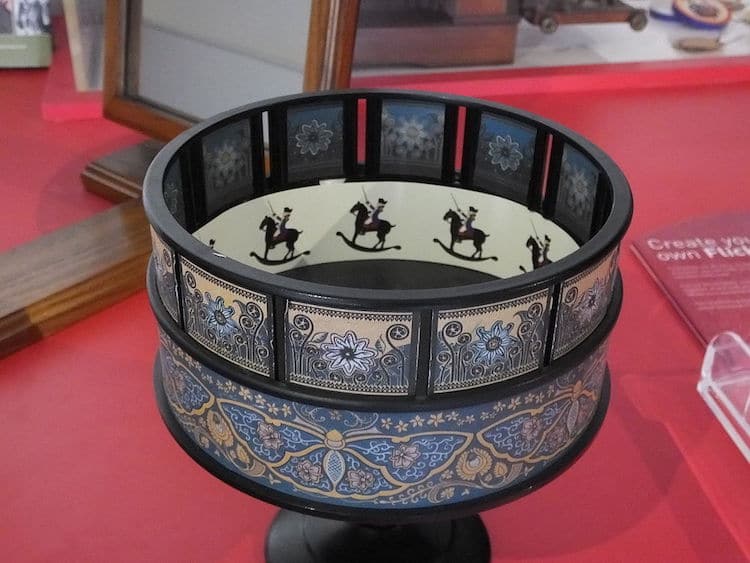What are Zoetropes?
The zoetrope is a well-known pre-film animation device that creates the appearance of motion by displaying a series of drawings or images depicting different stages of that motion. It was first developed in the 1830s as a cylindrical version of the phénakisticope, which drew inspiration from stroboscopic discs. During the Victorian era, it gained popularity as a toy. The zoetrope is still in use today, having undergone updates and adaptations to produce 3D versions by businesses like Pixar. Learn more about the workings and art of this straightforward but useful technology in this article.

History of Zoetropes
The early origins of Zoetropes lie in the phénakisticope, as mentioned above. The earliest widely used animation device, the phenakisticope, was created in 1833 by Austrian inventor Simon Stampfer and Belgian physicist Joseph Plateau. It employed discs to simulate motion. This inspired British mathematician William Horner, who created the first zoetrope in 1834 and named it the Daedalum. Viewing apertures were positioned in between the images. The name “zoetrope,” which translates to “wheel of life” in Greek, was patented by William Lincoln in 1867. The London Stereoscopic and Photographic Company in the UK and Milton Bradley in the US offered the popular Victorian parlour toy. A massive 50-foot zoetrope exhibited at London’s Crystal Palace proved its popularity. The advent of motion movies in the late 1880s was made possible by animation innovations such as flip books and the praxinoscope.
Zoetropes experienced a revival in the late 20th century, with animator Eric Dyer creating ‘cine-tropes’ from 3D sculptures using camera shutter speeds instead of slits. Pixar Animation Studios also contributed to this revival by creating a 3D zoetrope featuring Toy Story 2 characters, which has been showcased in museums worldwide. Today, the looped sequences of GIF animations on the Internet are considered contemporary successors to the zoetrope.
Contemporary Artists Working with Zoetrope
-
Modern Maker of Zoetropes: Eric Dyer
Artist and educator Eric Dyer uses sculpture, installations, and sequential photographs to bring animation into the real world. After years of using a computer to create screen-based visuals, Dyer’s work has been widely shown at famous locations like Times Square, the Cairo and Venice Biennales, the Smithsonian National Gallery of Art, Ars Electronica, and international animation festivals spanning several nations. Among the honors bestowed upon him are the titles of Fulbright Fellow, Guggenheim Fellow, Creative Capital Artist, and Sundance New Frontier Artist. Books like Reimagining Animation: The Changing Face of the Moving Image, Pervasive Animation, and Animation: A Comprehensive Study of Motion in Art have highlighted Dyer’s committed investigation of motion in art. “To me, zoetropes are like time sculptures — film and animation all contained within a single object,” explains Eric Dyer in a video profile by Creative Capital. Dyer’s latest artistic endeavor transforms the tactile joys of the zoetrope into a fully immersive experience. He has crafted a Zoetrope Tunnel, a three-dimensional spinning space that envelops viewers in an animated vision. Participants enter the space with a flashlight in hand, illuminating a constantly shifting visual environment. As Dyer describes it, they are “essentially moving through the sculptural film.”

-
New age Artist: Mat Collinshaw
London-based artist Mat Collishaw was inspired by the tale of “The Massacre of the Innocents” to create a 3D-printed zoetrope named All Things Fall in 2014. This artwork is powered by an electric motor and features LED lighting. It is made of steel, aluminum, plaster, and resin. Around 350 character figures, environment parts, and architectural components were created over six months at Sicnova 3D, where each meticulous model figure was 3D printed utilizing ABS (Acrylonitrile Butadiene Styrene) material. Collishaw explained that the original paintings of “The Massacre of the Innocents” thrive on the repetition of characters spread across the canvas, designed to provoke emotions and keep viewers’ eyes moving in an agitated manner without intimacy or a focal point. The zoetrope amplifies this effect by literally repeating characters to create an overwhelming and compelling depiction of violence.

-
Japanese Zoetrope Maker, Akinori Goto
In his work across multiple media, Japanese artist Akinori Goto combines classic animation methods with contemporary technologies. His creation, Toki, is a 3D-printed zoetrope that, when illuminated from the side, displays several moving figures. This work was shown at the 2016 Spiral Independent Creators Festival, where it was awarded the Audience Award in addition to the Runner-up Grand Prix. Since then, Goto has used the same method to construct a large number of different zoetropes, one of which depicts the captivating motions of ballet dancers.

A rich and lengthy history of inventive techniques for producing the appearance of motion may be found in animation. Optical toys and handcrafted gadgets from the 19th century provided entertainment for humans long before movie films. Rather than projecting images onto a screen, these early technologies let people watch the animation one at a time. One such gadget is the zoetrope, whose alluring visual effects are still valued today.The zoetrope has been brought back to life in recent years by contemporary artists who have combined old methods with cutting-edge technology. They are revitalizing this lost art form, displaying its eternal appeal, and captivating audiences once more by fusing digital animations and 3D printing.
References
- https://www.huffpost.com/entry/eric-dyer_n_6680972
- https://parametric-architecture.com/all-things-fall-breathtaking-3d-printed-zoetrope-by-mat-collishaw/
- https://www.ted.com/speakers/eric_dyer
- https://mymodernmet.com/andymation-anime-flipbook/
- https://mymodernmet.com/what-is-a-zoetrope/.






